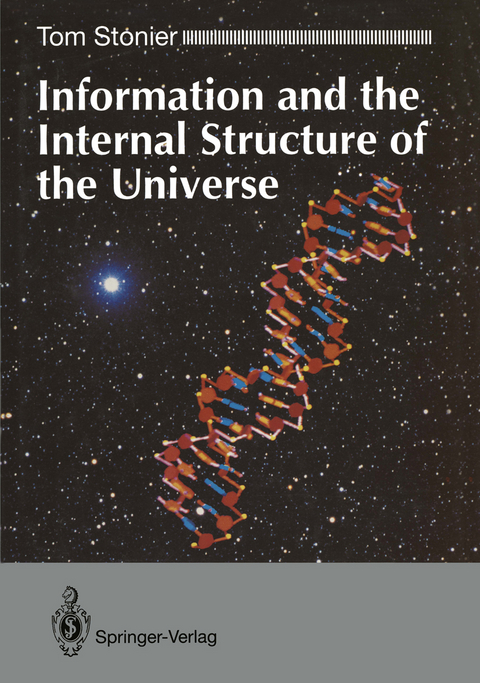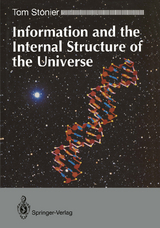Information and the Internal Structure of the Universe
Springer Berlin (Verlag)
978-3-540-19878-9 (ISBN)
The first of a planned trilogy, this book examines the proposition that "Information" is as much a part of the physical universe as energy and matter. The acceptance of such a proposition has profound implications for the physical sciences; it also lays the foundations for a general theory of information. This book is directed firstly at researchers in information theory and scientists in other disciplines. However, its relatively non-mathematical nature and accessible writing style place it at the "scientific" end of the spectrum of popular science books. A general theory of information will emerge in the second volume; the third will examine the mechanism and evolution of human and machine intelligence.
Not so if the book has been translated into Arabic. Now the reader can discern no meaning in the letters. The text conveys almost no information to the reader, yet the linguistic informa tion contained by the book is virtually the same as in the English original. The reader, familiar with books will still recognise two things, however: First, that the book is a book. Second, that the squiggles on the page represent a pattern of abstractions which probably makes sense to someone who understands the mean ing of those squiggles. Therefore, the book as such, will still have some meaning for the English reader, even if the content of the text has none. Let us go to a more extreme case. Not a book, but a stone, or a rock with engravings in an ancient language no longer under stood by anyone alive. Does such a stone not contain human information even if it is not decipherable? Suppose at some point in the future, basic knowledge about linguistics and clever computer aids allow us to decipher it? Or suppose someone discovers the equivalent of a Rosetta stone which allows us to translate it into a known language, and then into English? Can one really say that the stone contained no information prior to translation? It is possible to argue that the stone, prior to deciphering contained only latent information.
Prologue.- The Author's Dilemma.- 1 Information: Abstraction or Reality?.- Can Information Exist Outside the Human Brain?.- Can Information be Processed Outside the Human Brain?.- Forms of Human Information and its Communication.- Biological Information Systems.- Inorganic Information Systems.- Non-human Information Processing.- Some Epistemological Considerations.- 2 Information Physics: An Introduction.- The Reality of Information.- The Heart of the Concept.- Information: The Hidden Dimension.- 3 Information and Entropy: The Mathematical Relationship.- Information and Organisation.- The Second Law of Thermodynamics.- The Boltzmann/Schrödinger Equation.- Information as an Inverse Exponential Function of Entropy.- The Constant c.- 4 Measuring the Information Changes of Altered Physical States.- Measuring the Information Content of a Crystal.- Proteins as Information Systems.- The Denaturation of Trypsin.- Concluding Remarks.- 5 Information and Entropy: Further Implications.- Information and Entropy as Viewed by the Communications Engineers.- Positive Entropy.- Negative Entropy.- Information Magnitudes.- The Evolution of the Universe.- 6 Some Further Considerations About the Interrelationship Between Information and Energy.- Pure Energy: Heat, the Antithesis of Information.- The Information Content of Energy.- Motion, Distance and Time.- Information and Potential Energy.- The Interconversion of Energy and Information.- Information Machines.- Structural vs Kinetic Information.- Transformations Between Kinetic and Structural Information.- 7 Information and Work.- The Relationship Between Work and Information.- Energy Transducers.- Work in Biological Systems.- Reassessing the Work Equations.- Measuring the Information Content of Electrical Work.- 8 Summary and ConcludingRemarks.- The Basic Propositions.- Historical Perspective.- Why Has Information Been Overlooked?.- The Need for Models and Theories.- The Relevance of Information Physics for a General Theory of Information.- Some Concluding Thoughts.- Appendixes.- A. Speculations on Electromagnetic Radiation and Particles of Information.- B. Further Speculations: Implications for Atomic Structure.- C. A Smaller Universe.- D. Other Universes?.
| Erscheint lt. Verlag | 25.2.1994 |
|---|---|
| Zusatzinfo | XI, 155 p. |
| Verlagsort | London |
| Sprache | englisch |
| Maße | 170 x 242 mm |
| Gewicht | 302 g |
| Themenwelt | Informatik ► Theorie / Studium ► Kryptologie |
| Schlagworte | ACCESS • Communication • Complexity • Entropy • Evolution • Information • Information Theory • Intelligence • PROLOG • thermodynamics |
| ISBN-10 | 3-540-19878-4 / 3540198784 |
| ISBN-13 | 978-3-540-19878-9 / 9783540198789 |
| Zustand | Neuware |
| Haben Sie eine Frage zum Produkt? |
aus dem Bereich




